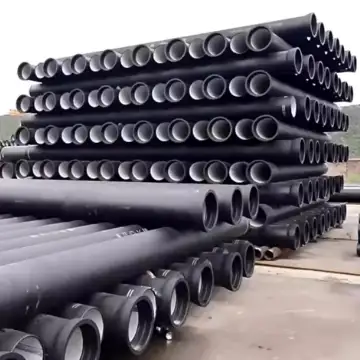Today, I delivered a lecture on ductile iron pipes at a university, discussing ductile iron double-flanged pipes. Many students expressed keen interest in the design featuring flanges at both ends. Consequently, I’ve decided to compose a comprehensive article detailing the technical aspects of double-flanged ductile iron pipes to serve as a reference for all interested parties.
Ductile iron double-flanged pipes feature two flanged ends designed to connect with bolts and gaskets, forming leak-proof joints. The superior strength and corrosion resistance of ductile iron make these pipes an ideal choice for transporting potable water, wastewater, and other pressurized fluids.
1. What Are Ductile Iron Double Flanged Pipes?
Ductile iron double-flanged pipes are a type of pipe used primarily in water distribution systems. Unlike traditional pipes, which may have a single flanged end, these pipes are designed with flanges at both ends, allowing for easy connection to other pipes or fittings. The flanges are typically made of the same material as the pipe itself—ductile iron—ensuring uniform strength and durability. The pipe’s internal lining, often cement mortar, helps to resist corrosion and extend the life of the pipe in challenging environments.
2. Key Features of Ductile Iron Double Flanged Pipes
Ductile iron pipes are favored for their high tensile strength, excellent corrosion resistance, and flexibility. The primary features include:
-
High Pressure Resistance: These pipes can handle higher pressures than many other pipe materials, making them suitable for water and wastewater systems where pressurized flow is necessary.
-
Corrosion Resistance: The external and internal coatings (such as cement mortar linings) protect the pipes from rust and corrosion, even when exposed to aggressive environmental conditions.
-
Durability: Ductile iron’s strength allows these pipes to endure mechanical stresses, impacts, and vibrations without cracking or deforming.
-
Ease of Installation: The double-flanged design allows for a straightforward installation process. The flanges can be easily bolted together, ensuring a tight, secure joint.
3. Applications of Ductile Iron Double Flanged Pipes
These pipes are widely used in various industries due to their ability to transport fluids reliably under pressure. Common applications include:
-
Water Distribution Systems: Due to their high strength and corrosion resistance, ductile iron double-flanged pipes are ideal for municipal water supply networks.
-
Sewer Systems: They are also extensively used in wastewater and sewage systems, where durability against chemical exposure is critical.
-
Industrial Pipelines: Industries dealing with chemicals or high-pressure systems prefer ductile iron pipes because of their versatility and robustness.
4. Advantages of Ductile Iron Double Flanged Pipes
The use of ductile iron double-flanged pipes offers several significant advantages:
-
Cost-Effectiveness: While ductile iron pipes may have a higher upfront cost than PVC or steel pipes, their long service life and low maintenance costs provide significant savings in the long run.
-
Strength and Flexibility: Ductile iron’s unique ability to withstand high pressure and its flexibility in terms of bending and connection options make it the perfect choice for infrastructure projects.
-
Longevity: With proper maintenance, these pipes can last for 50 to 100 years, depending on the environmental conditions and usage.
5. Comparison Table: Ductile Iron Double Flanged Pipes vs. Other Types
| Property | Ductile Iron Double Flanged Pipes | PVC Pipes | Steel Pipes |
|---|---|---|---|
| Pressure Rating | High | Medium | Very High |
| Corrosion Resistance | Excellent | Poor | Moderate |
| Durability | Long-lasting (50-100 years) | 20-40 years | 30-50 years |
| Installation Complexity | Medium | Easy | Medium |
| Cost | Medium | Low | High |
6. Case Study: Application of Ductile Iron Double Flanged Pipes in a Municipal Water System
A recent project in a mid-sized city involved replacing old, corroded steel pipes with ductile iron double-flanged pipes for the local water distribution network. The old steel pipes had been leaking and causing water loss, and their corrosion had begun to compromise the quality of drinking water. By switching to ductile iron, the city was able to significantly reduce maintenance costs, improve water flow, and extend the lifespan of their system by over 30 years. The choice of double-flanged pipes simplified the installation process, as they could be quickly and securely connected to existing infrastructure.
7. Frequently Asked Questions (FAQs)
-
What is the difference between ductile iron pipes and cast iron pipes?
-
Ductile iron pipes have a higher tensile strength than cast iron pipes, allowing them to withstand greater pressure and stresses. While cast iron pipes can be brittle, ductile iron pipes are much more flexible and durable.
-
-
Can ductile iron double-flanged pipes be used for gas transportation?
-
While ductile iron pipes are primarily used for water and wastewater systems, they can be used for gas transport with the appropriate coating and safety measures. However, specialized materials like steel are more commonly used for gas pipelines.
-
-
How long can ductile iron double-flanged pipes last?
-
With proper maintenance, these pipes can last anywhere from 50 to 100 years, depending on the environmental conditions and the type of coating used.
-
-
Are ductile iron pipes environmentally friendly?
-
Yes, ductile iron pipes are environmentally friendly as they are 100% recyclable and have a long lifespan, which reduces the need for frequent replacements.
-
-
What factors affect the cost of ductile iron double-flanged pipes?
-
The main factors affecting the cost include the diameter of the pipes, the type of coating used, and the region in which the pipes are purchased. Bulk orders or custom sizes may also impact the price.
-
8. Conclusion
Ductile iron double-flanged pipes are an essential component in modern water and wastewater infrastructure. Their strength, flexibility, and long-lasting performance make them ideal for a wide range of applications. By choosing the right materials and installing these pipes correctly, municipalities and industries can ensure the reliability and efficiency of their piping systems for decades to come.

